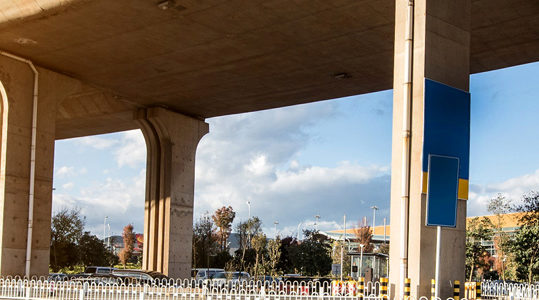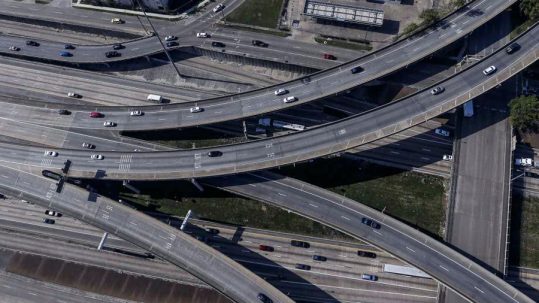
14 Jul Texas highway funding gets $9 billion boost, including I-45 projects
A sweeping revision of state highway plans adds nearly $9 billion in new funds for improving Texas roadways, including a $1.32 billion infusion in the Houston area for a major overhaul of Interstate 45 and nine other projects.
Projects along Texas 36 in Fort Bend and Brazoria counties and Texas 105 in Montgomery and San Jacinto counties are also included in the unified transportation plan approved Tuesday in Austin by the Texas Transportation Commission.
“This is a major step forward,” said Commissioner Bruce Bugg.
The newly approved plan adds 230 projects and $8.9 billion in funding statewide.
The plan – updated annually in phases – guides all state highway, maritime and aviation spending. Projects across the state show up first in the plan, with the money for them tied to upcoming fiscal years for the Texas Department of Transportation.
All the projects are dwarfed by the I-45 project. Last month, officials called it the type of project that comes around once every 50 years.
“We are trying to make long-term improvements, and we believe we’ve made them,” said Quincy Allen, TxDOT Houston district director.
In the Houston area, the updated plan marks a massive increase in highway investment, primarily through a windfall of money from two voter-approved highway spending proposals in 2014 and 2015 that accelerated the redesign of Interstate 45 through Houston’s central business district.
“Houston’s problems are in the downtown area, first and foremost,” said Lauren Garduno, TxDOT’s director of project and planning and development.
Construction is expected to start in late 2020 on the first of seven separate projects that will realign I-45 along downtown’s eastern side, parallel to Interstate 69, also known as U.S. 59 in the Houston area.
The first projects will reconstruct I-69 between Spur 527, which leads into Midtown, and I-45, including the interchange with Texas 288. That will be followed by a rebuild of I-45 at its interchange with I-69.
Combined, the two interchanges – technically four projects on TxDOT’s books – are expected to cost nearly $1.7 billion. That is more than half the $3 billion cost of remaking I-45 around downtown, which includes removing the segment of I-45 along the Pierce Elevated.
Constant chokepoint
The area south of the central business district is by many measures the worst chokepoint in the state. It is one of only two places in Texas – the other being downtown Dallas – where three of the 15 most-congested road segments intersect. Harris County Judge Ed Emmett frequently notes I-69 is jammed both inbound and outbound during most of the workday and commuting periods.
For drivers, the delay at the freeway crossings and along the interstates is a near-constant nightmare.
“It adds 30 minutes, minimum, to my round-trip,” Paul Jacoby said of his commute from Braeburn, southwest of Bellaire, to downtown Houston.
Multiply that by the estimated 170,000 vehicles daily using I-69 between Texas 288 and I-45, and it translates to more than 21 million lost hours along that single stretch of freeway.
Easing congestion
The intensity of time lost in major metro areas led state officials, at the direction of Gov. Greg. Abbott, to focus $1.3 billion annually on congestion-relief projects in Houston, Dallas, Fort Worth, San Antonio and Dallas. Houston will get about one-third of those funds over the next decade as part of its overall allocation under the unified plan.
Traffic in the five metro areas is expected to worsen as Texas balloons from a population of 27 million in 2015 to an estimated 54 million by 2050.
“We know we have congestion problems today, but we are mindful of those new Texans joining us in the future,” Bugg said earlier this month during a discussion with reporters of the initiative, called Texas Clear Lanes.
That rationale led TxDOT districts to accelerate long-sought projects, such as the I-45 project in Houston and other high-priority projects outside Loop 610.
Unlike the downtown Houston project, which will wait years to start, some of the work will start by the end of the year on three key projects, announced in January 2016.
Next month, TxDOT is scheduled to open bids on the next phase of widening I-45 in League City, continuing a decade-long slog toward Galveston, making the freeway four lanes in each direction with frontage roads.
Typically, construction begins about three to four months after bids are opened. If that timing holds, two months after I-45 work moves south, drivers frustrated on their way to Austin when westbound Interstate 10 drops to two lanes in Brookshire will start seeing orange cones. Crews will widen the freeway to three lanes in each direction to the Brazos River.
Just before or after the holiday season, work will begin on a third project to reconstruct some of the connections where I-69 crosses Loop 610 near Uptown, as well as rebuild Loop 610 through the intersection.
TxDOT expects all of the projects to finish in 2021, around the time downtown interchanges will start to see construction.
Funding uncertain
As they cheered the upcoming investments, state transportation officials also sounded a note of caution.
While the commission can program money, they do so with what state budget writers – members of the Legislature – provide in upcoming budgets. Some state lawmakers have already discussed holding back on some of the spending related to Proposition 1, which voters approved in 2014, directing money from the state’s so-called rainy day fund.
Uncertainty also clouds federal money, another major source of how Texas widens roads, said transportation commissioner Jeff Austin.
Transportation commissioner Victor Vandergriff urged officials to keep in mind it will take many decisions in Austin and potentially in local communities to keep many projects moving toward construction, and not all of them will make it.
“The facts are, there are never enough dollars out there for every project, and we are going to be limited at the state level with what we can do,” Vandergriff said, noting a host of funding alternatives and considerations about how to expand roads.
“We know we are going to have to address that,” he said. “Not us, the state of Texas.”












No Comments